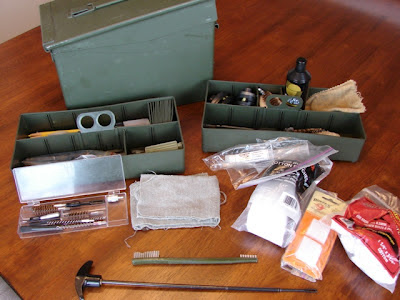Sights
I prefer night sights on my handguns. These are sights that glow in low light/no light and provide you with a sight picture in all conditions.
They are about $160 to add onto a gun after purchase or $100 if you can do it yourself (and they are hard to do—I have done them). It is best to buy a gun with these sights installed and properly zeroed.
Night sights have a 12 year life limited by the radioactive isotope (Tritium) that is used in them. Yes, that sounds scary, but it’s not. If buying a used gun or old stock, consider this lifespan. Most manufacturers will label the box with the born on date.
Magazines
Have at least five standard capacity magazines for your new handgun. You can buy them new on the internet or used and save a lot of money. Old magazines can be reconditioned with new springs. Only buy original manufacturer magazines for SD—do not buy aftermarket!
Consider adding high capacity magazines to the handgun for home defense.
Ammunition
Buy enough SD ammo (JHP) to fill three standard capacity magazines, minimum. If you can afford more, buy it! Buy a couple hundred rounds of FMJ ammo to keep for range/training. In a desperate situation, FMJ ammo can absolutely be used for SD. Test fire your ammo to make sure it feeds reliably in your weapon.
Consider stockpiling ammo gradually as your budget allows. A good rule of thumb is to have at least 1,000 rounds stockpiled if this is your only SD weapon. Some people will call me a “gun nut” for saying that. That’s not being a gun nut, that’s being prepared. Just because you have that much ammo doesn’t mean you have to use it.
The shelf life of ammunition, in ammo cans, is decades. Just last month I shot some South African 5.56MM NATO that was manufactured in 1983!!!
The shelf life of ammunition that is loaded in mags or carried in a gun is 6-12 months. The old SD ammo that has been loaded should be disposed of at the range for practice.
Cleaning Kit
My self-assembled universal cleaning kit
A cleaning kit is important to keep your weapon serviceable and cleaning a weapon isn’t as intuitive as most people think. Marines make weapon cleaning both an art form and a past time. If you know a Marine, he can teach you how to clean your weapon. If not, the gun store and YouTube can help.
At a minimum here are the items you need in your cleaning kit…
- Breakfree CLP (Clean, Lube, Protect – military issue gun cleaner)
- All Purpose (AP) brush – or toothbrush if you can’t find the AP
- Reel cloth
- Patches (specific to your caliber)
- Brass brush (again, for your caliber)
- Cleaning rod – short one is fine for handguns
- Patch puller (for running patches down the barrel)
This is really a $15 exercise unless you want a fancy organizer or ammo can.
If you are buying your gun in a gun shop, sometimes they will throw in a kit for free—never hurts to ask!
Training
Your ability to use a weapon to defend yourself isn’t complete until you have some level of training. Keep that in mind and talk to people.
Many classes are just a day or two during the weekend. A good beginner class will focus on the basics and you will spend more time in a classroom than on a range. More advanced classes will be on the range and require you to bring hundreds of rounds with you—do not start there.
Holsters / Magazine Carriers / Belts
Again, even if you don’t have the CCW permit, consider the fact that you may have to carry your weapon outside of your home. To safely do this you will need a holster and magazine carrier.
Have a decent belt that can support the weight of your weapon and reloads. There are good carry belts out there but they are expensive. A nice, real leather, department store 1.25-1.5” belt will do the trick—you probably already have one that will work.
Magazine carriers attach to your belt, are pretty easy to find, and are usually generic sizes. You will want to carry at least two additional magazines. Select a carrier that doesn’t dump your mags if you have to run--usually by tension or retention.
There are two main groups of holsters…
OWB
On WaistBand. These holsters loop onto the outside of the belt and are used for “open carry” unless concealed by a jacket. It is nearly impossible to conceal an OWB carried weapon absent a jacket/coat.
OWB holsters are generally the most comfortable holsters you can find because they get the weapon away from your body.
These holsters usually have some kind of retention system that keeps the weapon from leaving the holster unless you want it to. Think about which retention system makes sense to you.
IWB
In WaistBand. These holsters loop to the inside of the belt and are used for concealment—they are far less comfortable than OWB.
IWB holsters usually lack the retention system of OWB holsters. Some have no retention while others use molded kydex to provide a small amount of retention.
This method of concealment requires a lot of training and thought. This is not the kind of thing you pick up one day and are an expert on the next.
My favorite holster system is the Raven Concealment Phantom.
This holster can be IWB or OWB with the purchase of some extra accessories. It is a full length holster that protects the weapon from sweat when worn IWB. This system is expensive (plan on around $110 with shipping) but it does double-duty.


No comments:
Post a Comment